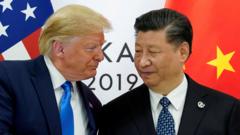As the upcoming NATO summit approaches, there is a renewed focus on defense spending, particularly regarding a proposal put forth by Secretary General Mark Rutte. Rutte's ambitious plan seeks to increase defense expenditures among member nations to 5% of their gross domestic product (GDP), a marked elevation from the current 2% target. This proposal emerges in the context of historical tensions between the United States and European allies regarding military funding and responsibilities.
**NATO's Shift: Proposal to Elevate Defense Spending to 5% of GDP Sparks Debate**

**NATO's Shift: Proposal to Elevate Defense Spending to 5% of GDP Sparks Debate**
In an effort to strengthen collective defense commitments, NATO leaders are urged to consider a substantial increase in defense spending.
At a recent press conference in Brussels, Rutte indicated that the intention behind this adjustment was both to support deterrence against potential aggressors like Russia and to appease prior criticisms from former President Donald Trump, who has frequently emphasized the need for European nations to bear more of the financial burden. The shift implies a significant reallocation of resources and reflects NATO's recognition of evolving security challenges.
European nations may face considerable hurdles in meeting the proposed increase. Rutte's suggestion introduces a partial framework wherein member states would incrementally raise their core defense budgets to 3.5%, with 1.5% potentially comprising broader defense-related expenditures. This flexibility offers some leeway, as Rutte noted that costs could include infrastructure and industrial investments.
While the United States, already at 3.4% spending, is likely to find compliance easier, the real challenge lies in ensuring adherence to the commitment over time. Many nations have yet to meet the older 2% pledge established more than a decade ago, raising questions about accountability and enforceability of the new proposal. Rutte voiced a strategy wherein nations would present annual plans outlining their intended progress, aimed at preventing last-minute spending surges.
The British defense plan currently anticipates reaching 2.5% of GDP by 2027, with aspirations for a 3% goal in subsequent terms, highlighting divergent approaches within NATO. As discussions unfold, the engagement of key players like the UK, France, and Germany remains critical in framing NATO's future commitments and unity.
US Defense Secretary Pete Hegseth reported optimism among various nations in achieving the 5% goal, underscoring the significance of unified progress. However, any substantive implementation will take time, potentially extending up to a decade, raising further considerations about NATO’s strategic direction amid shifting global dynamics.
European nations may face considerable hurdles in meeting the proposed increase. Rutte's suggestion introduces a partial framework wherein member states would incrementally raise their core defense budgets to 3.5%, with 1.5% potentially comprising broader defense-related expenditures. This flexibility offers some leeway, as Rutte noted that costs could include infrastructure and industrial investments.
While the United States, already at 3.4% spending, is likely to find compliance easier, the real challenge lies in ensuring adherence to the commitment over time. Many nations have yet to meet the older 2% pledge established more than a decade ago, raising questions about accountability and enforceability of the new proposal. Rutte voiced a strategy wherein nations would present annual plans outlining their intended progress, aimed at preventing last-minute spending surges.
The British defense plan currently anticipates reaching 2.5% of GDP by 2027, with aspirations for a 3% goal in subsequent terms, highlighting divergent approaches within NATO. As discussions unfold, the engagement of key players like the UK, France, and Germany remains critical in framing NATO's future commitments and unity.
US Defense Secretary Pete Hegseth reported optimism among various nations in achieving the 5% goal, underscoring the significance of unified progress. However, any substantive implementation will take time, potentially extending up to a decade, raising further considerations about NATO’s strategic direction amid shifting global dynamics.




















